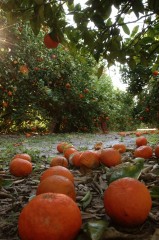Aug 14 2015
As citrus greening continues to impact Florida’s groves, growers have found that they need a way to quickly and accurately count the amount of fruit dropped early to help identify problem areas, which will save time and money.
 Fruit dropped early due to citrus greening.
Fruit dropped early due to citrus greening.
University of Florida researchers Wonsuk “Daniel” Lee, Daeun "Dana" Choi, Reza Ehsani and Fritz Roka devised a “machine vision system,” to count citrus fruit that has dropped early. The device is suitable for various conditions in citrus groves, including addressing problems of variable lighting, giving accurate estimates of dropped fruit counts and providing exact locations of trees with greater fruit drop, indicating a problem area.
“This machine could have significant economic value to citrus growers,” said Lee, an agricultural and biological engineering professor in UF’s Institute of Food and Agricultural Sciences. “First, fruit drop data would enable crop production estimates to be revised more accurately and timely during the course of a harvest season, and could also assist growers in scheduling their harvests to minimize fruit losses from the most affected areas.”
In addition, the researchers said, growers could use the data to detect where citrus greening is most prevalent in their groves. Growers could then implement management practices, such as fertilization programs and irrigation schedules, to fight greening and other diseases, and minimize the fruit drop. All of that would help cut costs and increase profits.
Presently, fruit drop data are collected by sampling random areas within a specific area and manually counting dropped fruit, which is costly and time consuming.
Other researchers have developed imaging machines, but had problems with the color resolution in their images, depending on the time of day pictures were taken. Like Monet paintings of the same subject created at different times of the day, colors can vary greatly depending on the light.
Lee and the UF/IFAS team created an outdoor imaging system with two cameras that deliver the three basic color components – red, green and blue –to obtain accurate color images. They were equipped with microprocessors and had special “charge-coupled device” sensors, which turn light into electrons for greater resolution. They were also designed with the conditions of citrus groves in mind: dusty and humid with high temperatures and low-hanging branches. Finally, a global positioning system receiver was attached.
Images were taken in May, 2013, in a commercial grove in Ft. Basinger, Fla., owned by Lykes Brothers, Inc., with the truck moving forward at an average speed of 5 miles an hour. Researchers took 180 images at three illumination levels – dark, medium and bright. Citrus fruit under dark illumination, due to cloud cover, appeared almost brown and there was no distinctive color variation between the background and the fruit, making it hard to count accurately. However, at medium and bright illumination, the fruit color was orange and bright yellow. Lee’s machine had an accuracy rate of as much as 88 percent.
The team’s research has been accepted for publication by the Transactions of the ASABE (American Society of Agricultural and Biological Engineers) journal.
The team is already working on a machine vision system using multiple video cameras with high-definition resolution. They plan to make their current machine vision system a real-time system that can be used easily in a commercial citrus grove.
Source: Wonsuk “Daniel” Lee, 352-392-1864 FREE, ext. 207, [email protected]